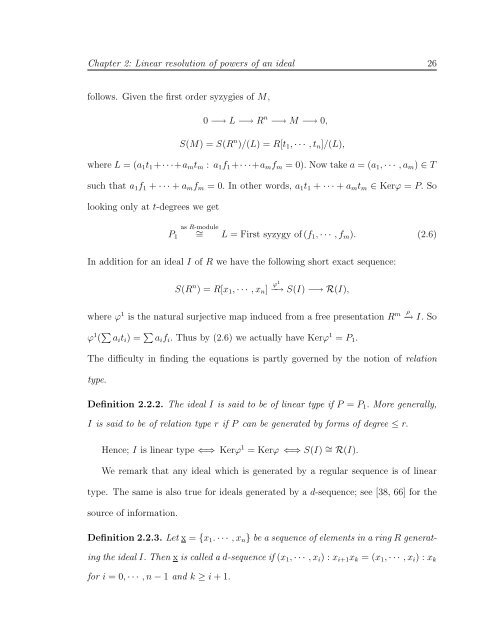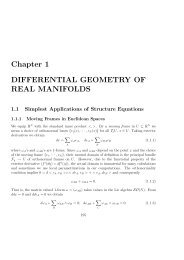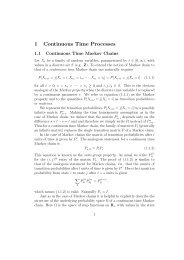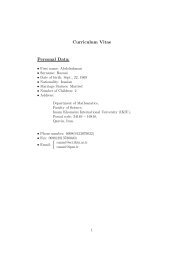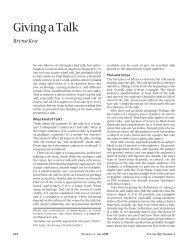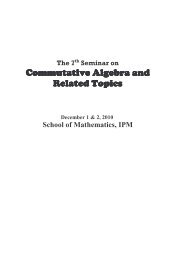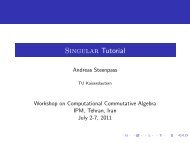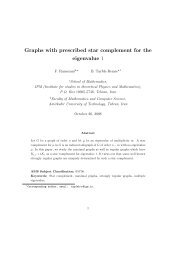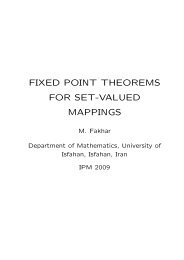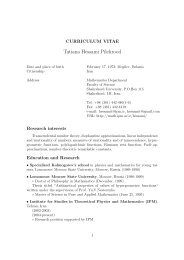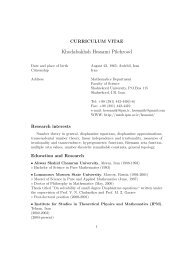Betti numbers of modules over Noetherian rings with ... - IPM
Betti numbers of modules over Noetherian rings with ... - IPM
Betti numbers of modules over Noetherian rings with ... - IPM
Create successful ePaper yourself
Turn your PDF publications into a flip-book with our unique Google optimized e-Paper software.
Chapter 2: Linear resolution <strong>of</strong> powers <strong>of</strong> an ideal 26<br />
follows. Given the first order syzygies <strong>of</strong> M,<br />
0 −→ L −→ R n −→ M −→ 0,<br />
S(M) = S(R n )/(L) = R[t1, · · · , tn]/(L),<br />
where L = (a1t1 +· · ·+amtm : a1f1 +· · ·+amfm = 0). Now take a = (a1, · · · , am) ∈ T<br />
such that a1f1 + · · · + amfm = 0. In other words, a1t1 + · · · + amtm ∈ Kerϕ = P. So<br />
looking only at t-degrees we get<br />
P1<br />
as R-module<br />
∼ = L = First syzygy <strong>of</strong> (f1, · · · , fm). (2.6)<br />
In addition for an ideal I <strong>of</strong> R we have the following short exact sequence:<br />
S(R n ) = R[x1, · · · , xn] ϕ1<br />
−→ S(I) −→ R(I),<br />
where ϕ 1 is the natural surjective map induced from a free presentation R m ρ −→ I. So<br />
ϕ 1 ( aiti) = aifi. Thus by (2.6) we actually have Kerϕ 1 = P1.<br />
The difficulty in finding the equations is partly g<strong>over</strong>ned by the notion <strong>of</strong> relation<br />
type.<br />
Definition 2.2.2. The ideal I is said to be <strong>of</strong> linear type if P = P1. More generally,<br />
I is said to be <strong>of</strong> relation type r if P can be generated by forms <strong>of</strong> degree ≤ r.<br />
Hence; I is linear type ⇐⇒ Kerϕ 1 = Kerϕ ⇐⇒ S(I) ∼ = R(I).<br />
We remark that any ideal which is generated by a regular sequence is <strong>of</strong> linear<br />
type. The same is also true for ideals generated by a d-sequence; see [38, 66] for the<br />
source <strong>of</strong> information.<br />
Definition 2.2.3. Let x = {x1. · · · , xn} be a sequence <strong>of</strong> elements in a ring R generat-<br />
ing the ideal I. Then x is called a d-sequence if (x1, · · · , xi) : xi+1xk = (x1, · · · , xi) : xk<br />
for i = 0, · · · , n − 1 and k ≥ i + 1.


